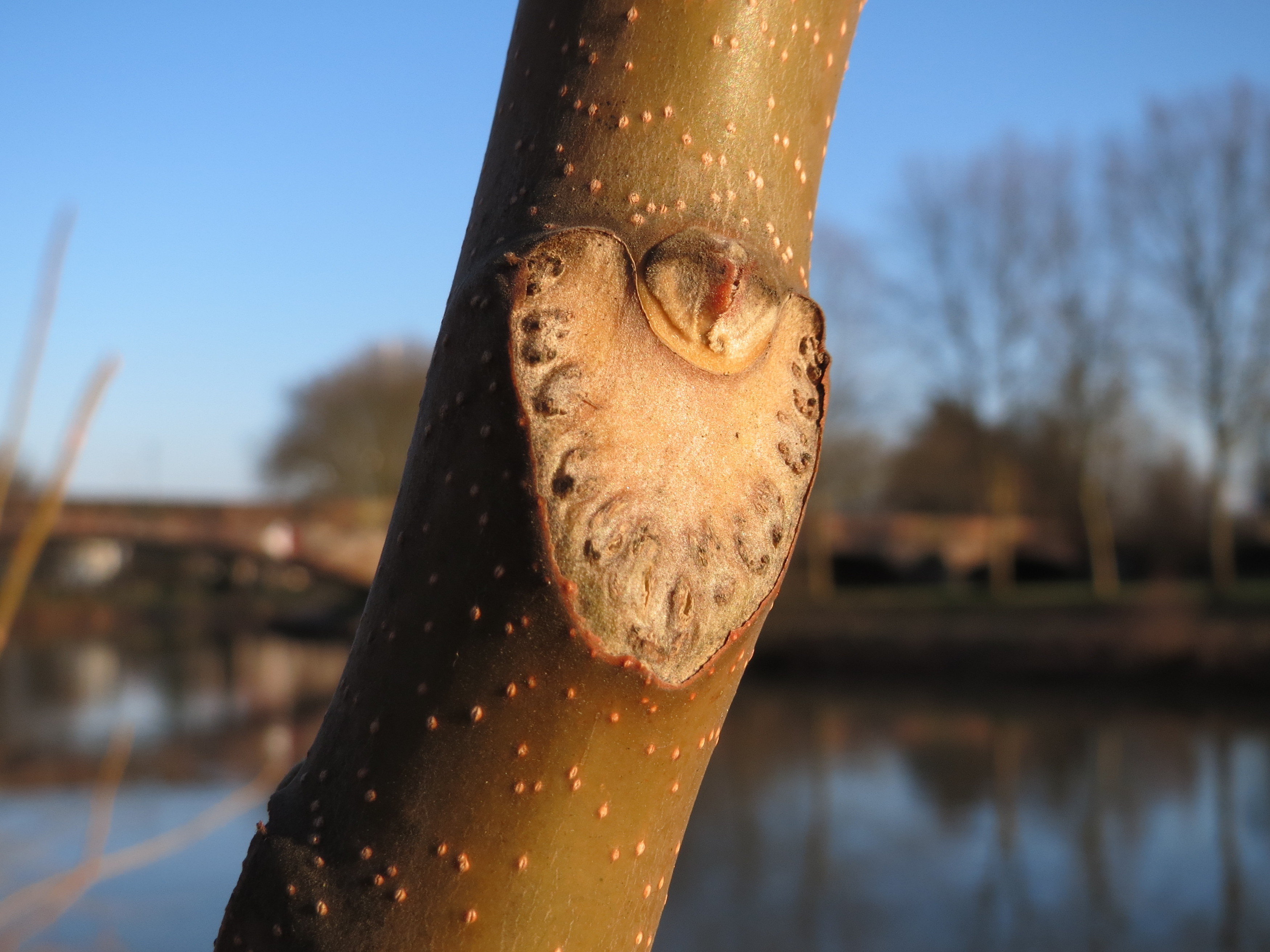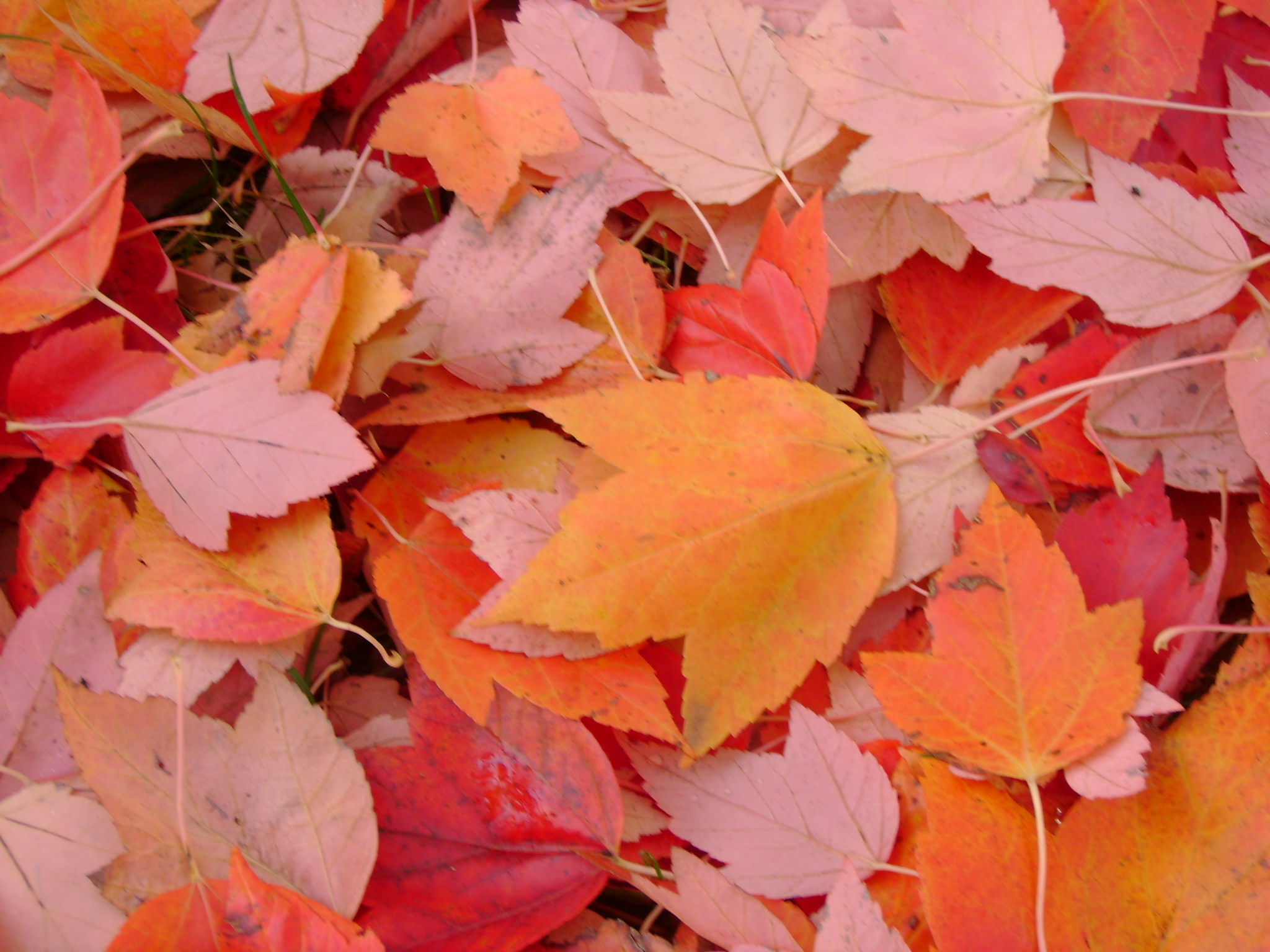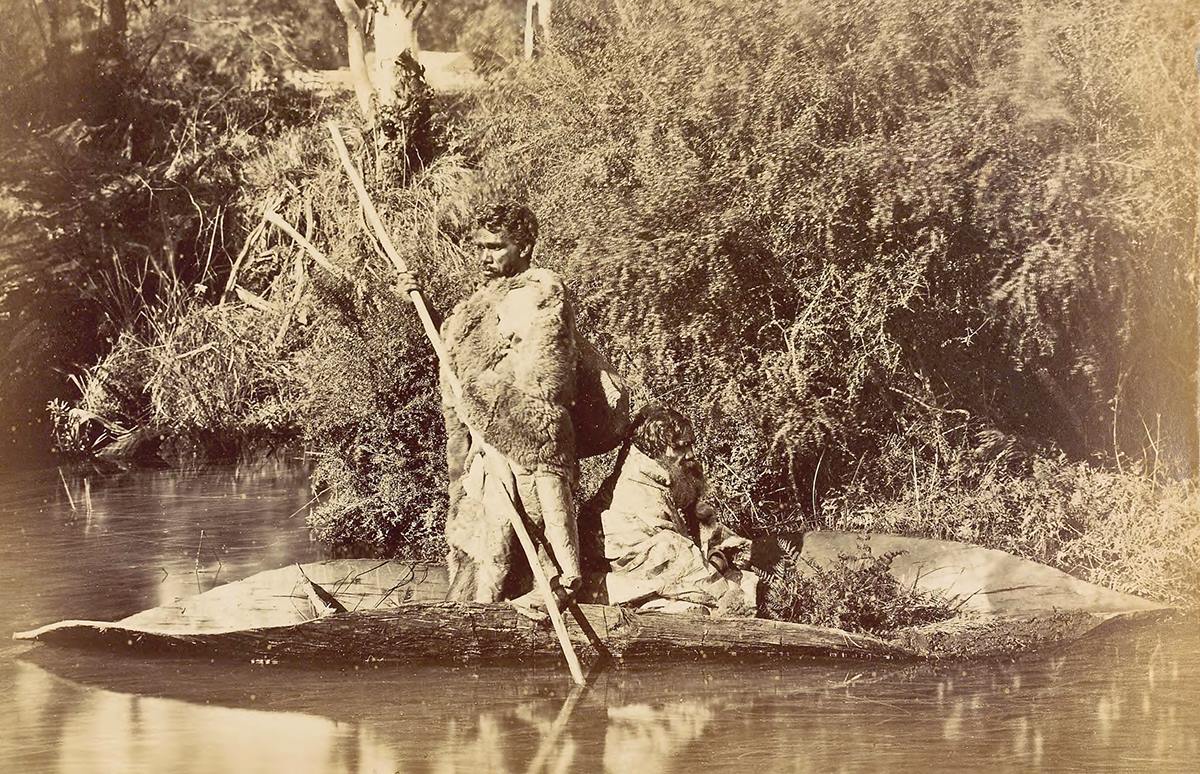|
Leaf Scar
A leaf scar is the mark left by a leaf after it falls off the twig. It marks the site where the petiole attached to the stem. A leaf scar is typically found below a branch, as branches come from axillary buds located above leaf scars. Formation Leaf scars are formed naturally, often at the end of the growing season for deciduous plants when a layer of cells called the abscissa layer forms between the petiole and stem. The abscission layer acts as a point of cleavage and the leaf breaks off leaving a cleanly shaped wound that is quickly healed over with protective cork. Stipules may also leave their own scars if they are present. Bundle scars Bundle scars are circular or barred regions within the leaf scar where bundles of vascular tissue that had connected the leaf and the stem broke off. The number of bundle scars in a leaf scar is sometimes used as an identifying mark as they are often consistent across a species. See also * Scar * Scarred tree A scarred tree or scar tre ... [...More Info...] [...Related Items...] OR: [Wikipedia] [Google] [Baidu] |
Leaf
A leaf (: leaves) is a principal appendage of the plant stem, stem of a vascular plant, usually borne laterally above ground and specialized for photosynthesis. Leaves are collectively called foliage, as in "autumn foliage", while the leaves, stem, flower, and fruit collectively form the Shoot (botany), shoot system. In most leaves, the primary Photosynthesis, photosynthetic Tissue (biology), tissue is the palisade mesophyll and is located on the upper side of the blade or lamina of the leaf, but in some species, including the mature foliage of ''Eucalyptus'', palisade mesophyll is present on both sides and the leaves are said to be isobilateral. The leaf is an integral part of the stem system, and most leaves are flattened and have distinct upper (Glossary of botanical terms#adaxial, adaxial) and lower (Glossary of botanical terms#abaxial, abaxial) surfaces that differ in color, Trichome, hairiness, the number of stomata (pores that intake and output gases), the amount and ... [...More Info...] [...Related Items...] OR: [Wikipedia] [Google] [Baidu] |
Petiole (botany)
In botany, the petiole () is the stalk that attaches the leaf blade to the Plant stem, stem. It is able to twist the leaf to face the sun, producing a characteristic foliage arrangement (spacing of blades), and also optimizing its exposure to sunlight. Outgrowths appearing on each side of the petiole in some species are called stipules. The terms wikt:petiolate, petiolate and wikt:apetiolate, apetiolate are applied respectively to leaves with and without petioles. Description The petiole is a stalk that attaches a leaf to the plant stem. In petiolate leaves the leaf stalk may be long (as in the leaves of celery and rhubarb), or short (for example basil). When completely absent, the blade attaches directly to the stem and is said to be Sessility (botany), sessile or apetiolate. Subpetiolate leaves have an extremely short petiole, and may appear sessile. The broomrape family Orobanchaceae is an example of a family in which the leaves are always sessile. In some other plant group ... [...More Info...] [...Related Items...] OR: [Wikipedia] [Google] [Baidu] |
Plant Stem
A stem is one of two main structural axes of a vascular plant, the other being the root. It supports leaf, leaves, flowers and fruits, transports water and dissolved substances between the roots and the shoots in the xylem and phloem, engages in photosynthesis, stores nutrients, and produces new living tissue. The stem can also be called the culm, halm, haulm, stalk, or thyrsus. The stem is normally divided into nodes and internodes: * The nodes are the points of attachment for leaves and can hold one or more leaves. There are sometimes axillary buds between the stem and leaf which can grow into branches (with leaf, leaves, conifer cones, or inflorescence, flowers). Adventitious roots (e.g. brace roots) may also be produced from the nodes. Vines may produce tendrils from nodes. * The internodes distance one node from another. The term "Shoot (botany), shoots" is often confused with "stems"; "shoots" generally refers to new fresh plant growth, including both stems and other str ... [...More Info...] [...Related Items...] OR: [Wikipedia] [Google] [Baidu] |
Axillary Bud
The axillary bud (or lateral bud) is an Plant embryogenesis, embryonic or Organogenesis#Plant organogenesis, organogenic Shoot (botany), shoot located in the axil of a leaf. Each bud has the potential to form shoots, and may be specialized in producing either vegetative shoots (stems and branches) or reproductive shoots (flowers). Once formed, a bud may remain dormant for some time, or it may form a shoot immediately. Overview An axillary bud is an embryonic or organogenic Shoot (botany), shoot which lies dormant at the junction of the plant stem, stem and Petiole (botany), petiole of a plant. It arises exogenously from outer layer of cortex (botany), cortex of the stem. Axillary buds do not become actively growing shoots on plants with strong apical dominance (the tendency to grow just the terminal bud on the main stem). Apical dominance occurs because the shoot apical meristem produces auxin which prevents axillary buds from growing. The axillary buds begin developing when the ... [...More Info...] [...Related Items...] OR: [Wikipedia] [Google] [Baidu] |
20150228Ailanthus Altissima1
Fifteen or 15 may refer to: *15 (number) *one of the years 15 BC, AD 15, 1915, 2015 Music *Fifteen (band), a punk rock band Albums * ''15'' (Buckcherry album), 2005 * ''15'' (Ani Lorak album), 2007 * ''15'' (Phatfish album), 2008 * ''15'' (Tuki album), 2025 * ''15'' (mixtape), a 2018 mixtape by Bhad Bhabie * ''Fifteen'' (Green River Ordinance album), 2016 * ''Fifteen'' (The Wailin' Jennys album), 2017 * ''Fifteen'', a 2012 album by Colin James Songs * "Fifteen" (song), a 2008 song by Taylor Swift *"Fifteen", a song by Harry Belafonte from the album ''Love Is a Gentle Thing'' *"15", a song by Rilo Kiley from the album ''Under the Blacklight'' *"15", a song by Marilyn Manson from the album ''The High End of Low'' Other media * ''15'' (film), a 2003 Singaporean film * ''Fifteen'' (TV series), international release name of ''Hillside'', a Canadian-American teen drama * "Fifteen" (''Runaways''), an episode of ''Runaways'' *Fifteen (novel), a 1956 juvenile fiction ... [...More Info...] [...Related Items...] OR: [Wikipedia] [Google] [Baidu] |
Deciduous
In the fields of horticulture and botany, the term deciduous () means "falling off at maturity" and "tending to fall off", in reference to trees and shrubs that seasonally shed Leaf, leaves, usually in the autumn; to the shedding of petals, after flowering; and to the shedding of ripe fruit. The antonym of deciduous in the botanical sense is evergreen. Generally, the term "deciduous" means "the dropping of a part that is no longer needed or useful" and the "falling away after its purpose is finished". In plants, it is the result of natural processes. "Deciduous" has a similar meaning when referring to animal parts, such as deciduous antlers in deer, deciduous teeth (baby teeth) in some mammals (including humans); or decidua, the uterine lining that sheds off after birth. Botany In botany and horticulture, deciduous plants, including trees, shrubs and herbaceous perennials, are those that lose all of their Leaf, leaves for part of the year. This process is called abscission. I ... [...More Info...] [...Related Items...] OR: [Wikipedia] [Google] [Baidu] |
Abscission
Abscission () is the shedding of various parts of an organism, such as a plant dropping a leaf, fruit, flower, or seed. In zoology, abscission is the intentional shedding of a body part, such as the shedding of a claw, husk, or the autotomy of a tail to evade a predator. In mycology, it is the liberation of a fungal spore. In cell biology, abscission refers to the separation of two daughter cells at the completion of cytokinesis. In plants Function A plant will abscise a part either to discard a member that is no longer necessary, such as a leaf during autumn, or a flower following fertilisation, or for the purposes of reproduction. Most deciduous plants drop their leaves by abscission before winter, whereas evergreen plants continuously abscise their leaves. Another form of abscission is fruit drop, when a plant abscises fruit while still immature in order to conserve resources needed to bring the remaining fruit to maturity. If a leaf is damaged, a plant may also abscise i ... [...More Info...] [...Related Items...] OR: [Wikipedia] [Google] [Baidu] |
Stipule
In botany, a stipule is an outgrowth typically borne on both sides (sometimes on just one side) of the base of a leafstalk (the petiole (botany), petiole). They are primarily found among dicots and rare among monocots. Stipules are considered part of the anatomy of the leaf of a typical flowering plant, although in many species they may be inconspicuous —or sometimes entirely absent, and the leaf is then termed ''exstipulate''. At the other end of the scale are species like ''Artocarpus elasticus'' where the stipules can be up to eight inches (twenty cm) in length. (In some older botanical writing, the term "stipule" was used more generally to refer to any small leaves or leaf-parts, notably prophylls.) The word ''stipule'' was coined by Carl Linnaeus, Linnaeus''Concise English Dictionary'' Wordsworth Editions Ltd. 1994, from Latin ''stipula'', straw, stalk. Types of stipules General characteristics The position of stipules on a plant varies widely from species to species, ... [...More Info...] [...Related Items...] OR: [Wikipedia] [Google] [Baidu] |
20150304Aesculus Hippocastanum1
Fifteen or 15 may refer to: *15 (number) *one of the years 15 BC, AD 15, 1915, 2015 Music *Fifteen (band), a punk rock band Albums * ''15'' (Buckcherry album), 2005 * ''15'' (Ani Lorak album), 2007 * ''15'' (Phatfish album), 2008 * ''15'' (Tuki album), 2025 * ''15'' (mixtape), a 2018 mixtape by Bhad Bhabie * ''Fifteen'' (Green River Ordinance album), 2016 * ''Fifteen'' (The Wailin' Jennys album), 2017 * ''Fifteen'', a 2012 album by Colin James Songs * "Fifteen" (song), a 2008 song by Taylor Swift *"Fifteen", a song by Harry Belafonte from the album ''Love Is a Gentle Thing'' *"15", a song by Rilo Kiley from the album ''Under the Blacklight'' *"15", a song by Marilyn Manson from the album ''The High End of Low'' Other media * ''15'' (film), a 2003 Singaporean film * ''Fifteen'' (TV series), international release name of ''Hillside'', a Canadian-American teen drama * "Fifteen" (''Runaways''), an episode of ''Runaways'' *Fifteen (novel), a 1956 juvenile fiction ... [...More Info...] [...Related Items...] OR: [Wikipedia] [Google] [Baidu] |
Scar
A scar (or scar tissue) is an area of fibrosis, fibrous tissue that replaces normal skin after an injury. Scars result from the biological process of wound repair in the skin, as well as in other Organ (anatomy), organs, and biological tissue, tissues of the body. Thus, scarring is a natural part of the healing process. With the exception of very minor lesions, every wound (e.g., after accident, disease, or surgery) results in some degree of scarring. An exception to this are animals with complete Regeneration (biology), regeneration, which regrow tissue without scar formation. Scar tissue is composed of the same protein (collagen) as the tissue that it replaces, but the fiber composition of the protein is different; instead of a random basketweave formation of the collagen fibers found in normal tissue, in fibrosis the collagen cross-links and forms a pronounced alignment in a single direction. This collagen scar tissue alignment is usually of inferior functional quality to the ... [...More Info...] [...Related Items...] OR: [Wikipedia] [Google] [Baidu] |
Scarred Tree
A scarred tree or scar tree, also known as a canoe tree and shield tree, is a tree which has had Bark (botany), bark removed by Aboriginal Australians for the creation of Canoe#Australia, bark canoes, humpy, shelters, weapons such as shields, tools, traps, containers (such as Coolamon (vessel), coolamons), or other Cultural artifact, artefacts. Carved trees may also be created as a form of artistic and spiritual expression by some Aboriginal peoples, to mark sites of significance such as burial sites. Trees in some areas are culturally modified in other ways that change their form, including "trees-in-trees". Description Bark was removed by making deep cuts in a tree with a stone pickaxe or other similar tool. The area of bark removed is typically regular in shape, often with parallel sides and slightly pointed or rounded ends, and the scar usually stops above ground level. Australian native Eucalypt species such as Eucalyptus melliodora, box and Eucalyptus camaldulensis, red g ... [...More Info...] [...Related Items...] OR: [Wikipedia] [Google] [Baidu] |






